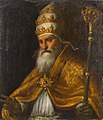Palma il Giovane
Palma Giovane | |
|---|---|
Italian | |
| Known for | Painting |
| Movement | High Renaissance |
Iacopo Negretti (1548/50
After
Biography
Palma was born in Venice. Born into a family of painters, he was the great-nephew of the painter Palma Vecchio ("Old Palma") and the son of Antonio Nigreti (1510/15–1575/85), a minor painter who was himself the pupil of the elder Palma's workshop foreman Bonifacio de' Pitati[4] and who after Bonifazio's death (1553) inherited Bonifacio's shop and clientele; the younger Palma seems to have polished his style making copies after Titian.
In 1567
Rejecting Mannerism in the 1580s, he embraced a reformist naturalism.[6] He varied the ingeniously synthesised amalgam according to subject matter and patrons' own eclectic and conservative tastes, with "virtuoso skill and a facile intelligence".[7]

He worked alongside Veronese and Tintoretto on the decorations in the Doge's Palace where he came to know fully the Venetian tradition. From 1580-90 he painted cycles of large canvases either for Venetian Schools or sacred buildings (the sacristies of
Palma il Giovane went on to organize his own, large studio which he used to produce a repetitive series of religious and allegorical pictures that can be found throughout the territory of the Venetian Republic. One of these works is Venus with a Mirror (after Titian). After 1600 he painted mythologies for a small circle of intellectuals. After the death of Tintoretto in 1594, he remained one of the leading painters in the City of Venice. He was commissioned to complete Titian’s unfinished Pietà. Palma proudly stated: ‘QUOD TITIANVS INCHOATVM RELIQUIT PALMA REVERENTVR ABSOLVIT DEOQ. DICAVIT OPVS’[9]
He was interred in the Basilica di San Giovanni e Paolo, a traditional burial place of the doges. Among his followers was the Brescian painter, Camillo Rama.
Gallery
-
Crucifixion, Madonna dell'Orto
-
Venus and Mars, ca. 1590, The National Gallery, London
-
Yael Killing Sisera
-
Madonna and Child, St. Benedict and other saints, 1605, San Zaccaria, Venice
-
Davide vincitore...San Zaccaria, Venice
-
Pope St.Pius V
-
Venus with a Mirror
-
St Jerome in the Wilderness, ca. 1590–1595
-
Paolo Veronese, ca. 1600–1610
See also
Notes and references
- ^ Spelling and dates as in Sydney J. Freedberg, Painting in Italy 1500-1600, 3rd ed. (Yale University Press) 1993:560-62.
- ^ "Jacopo Palma called Palma Giovane, in Federico Zeri, Italian Paiuntings (Metropolitan Museum of Art), 1973:45.
- S. J. Freedbergcharacterises him among Venetian painters as "the only painter of this generation to exhibit a semblance of vitality, even within formulae based mostly upon Tintorettesque style." (Freedberg 1993:560).
- ^ Bonifacio inherited the elder Palma's workshop in 1528; see Philip Cottrell, "The Artistic Parentage of Palma Giovane" The Burlington Magazine 144 No. 1190 (May 2002), pp. 289-291.
- ^ Freedberg 1993:561.
- San Giacomo dell'Orio, Venice, before 1584, then more conspicuously in the histories of the Doge Pasquale Cicogna in the Oratorio dei Crociferi, Venice1586–87.
- ^ Freedberg 1993:561.
- ^ "Roberto Gagliardi - Biography". 23 March 2014.
- ^ Jacopo Negretti, called Palma il Giovane https://www.dorotheum.com/en/l/6718305/ Retrieved: 2021.02.06
External links
- Italian Paintings, Venetian School, a collection catalog containing information about the artist and his works (see Jacopo Palma the Younger in index; plates 52-53).









